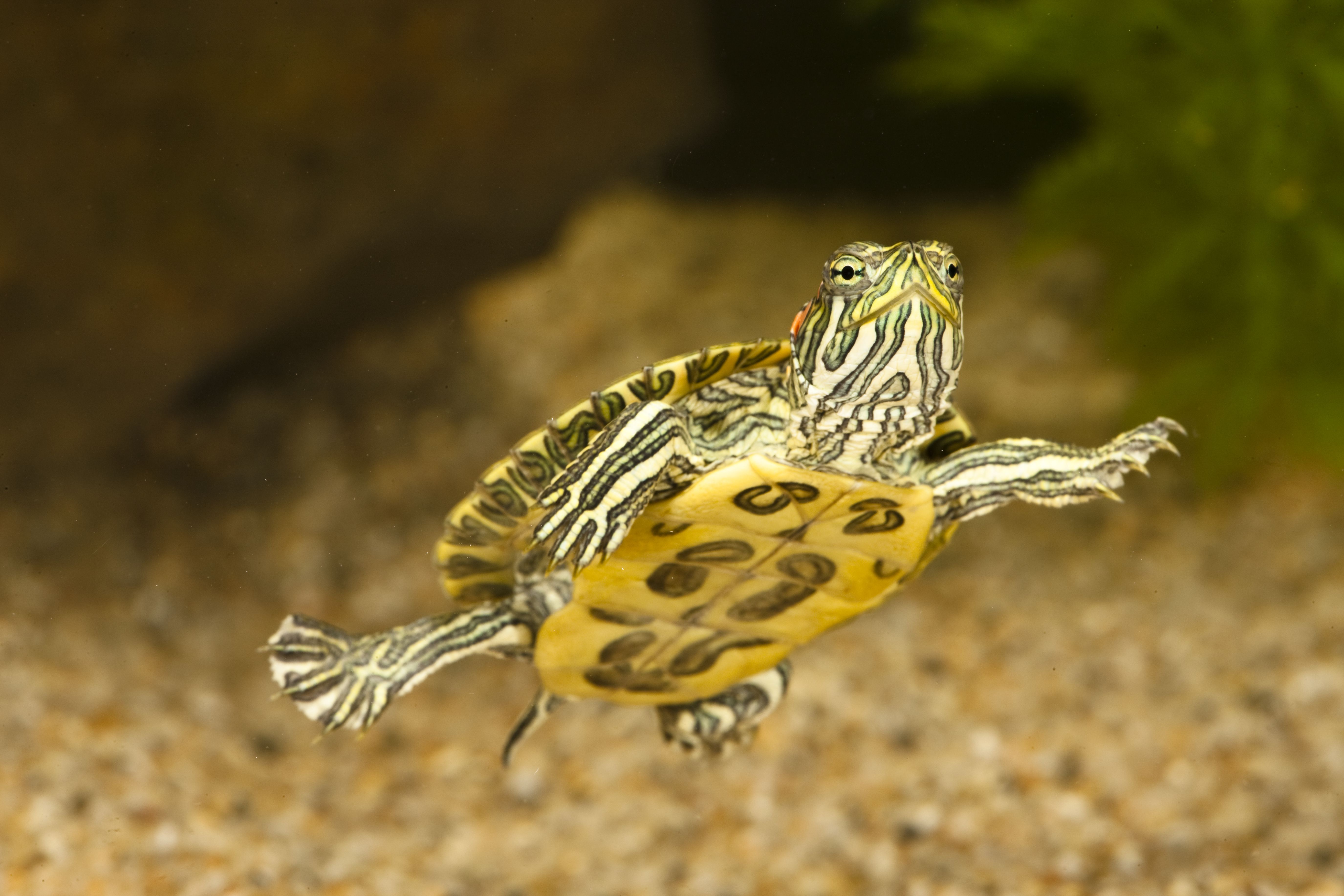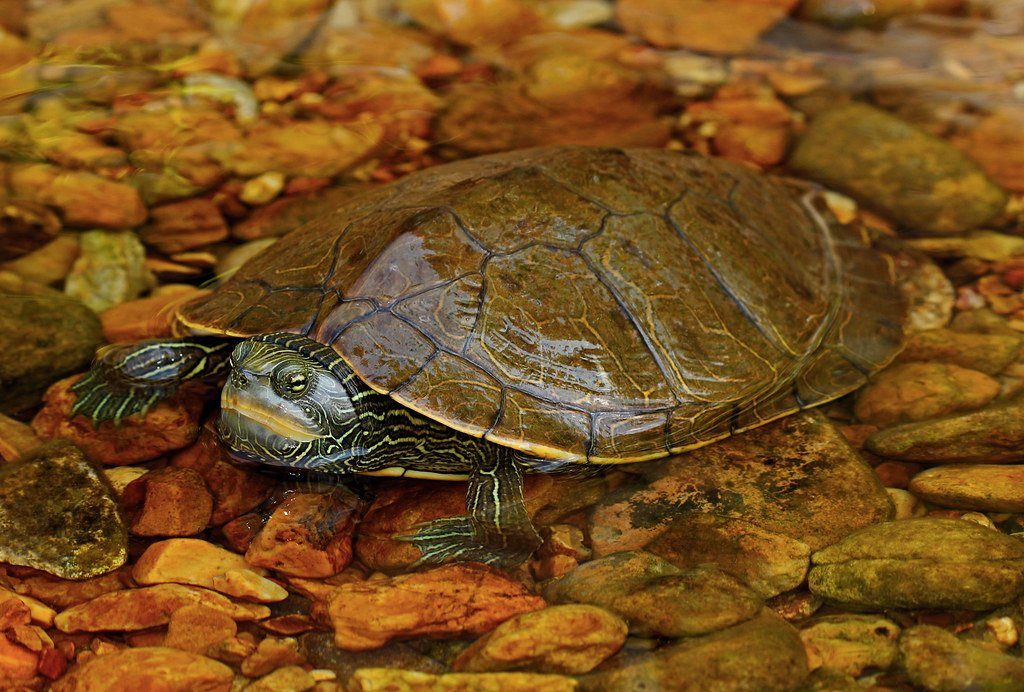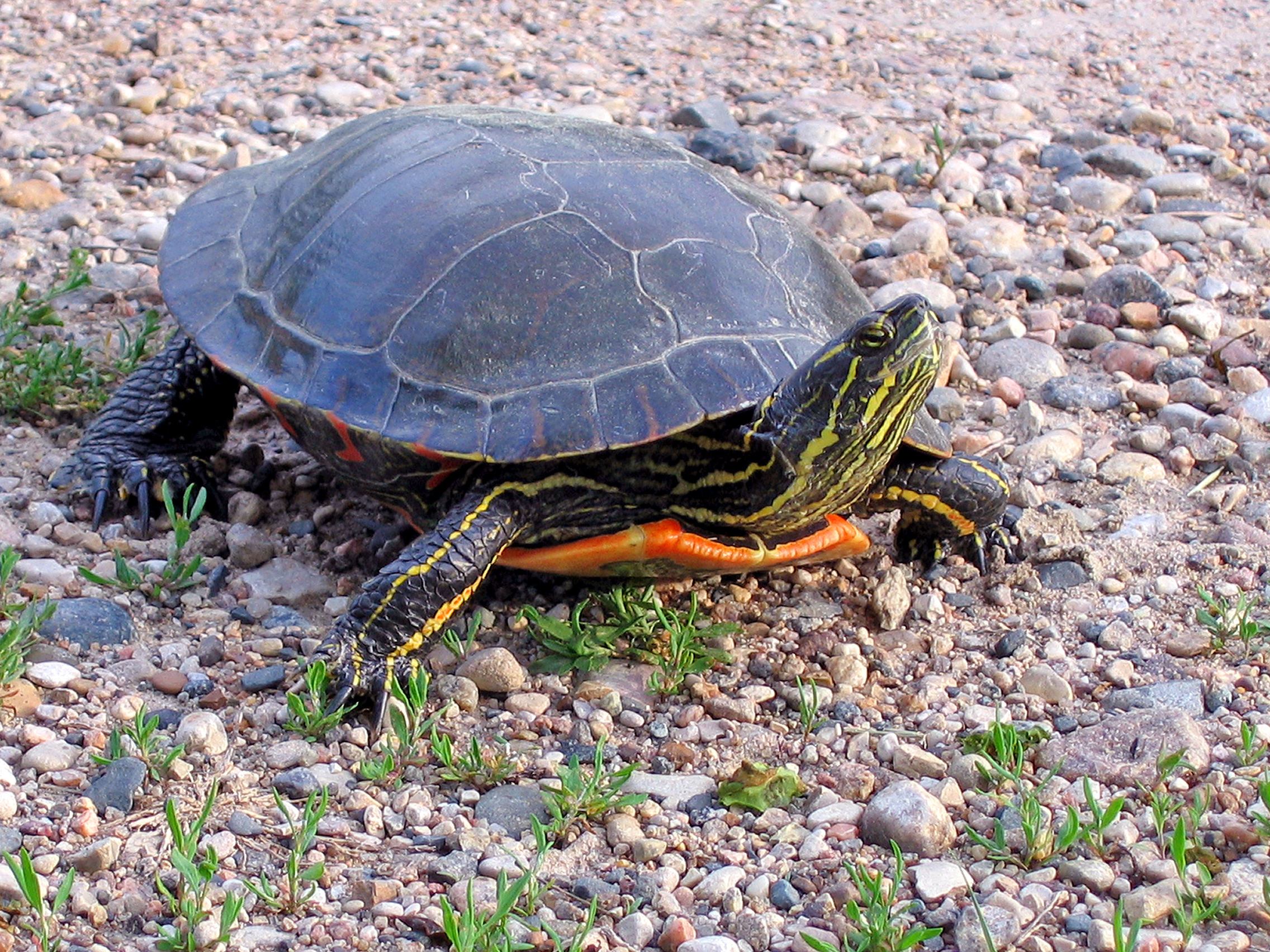Pond turtles are a type of freshwater turtle that can be found in ponds, lakes, and other quiet waters. There are many different species of pond turtles, each with their own unique characteristics and care requirements. Some species make better pets than others, and it’s important to do your research before getting a turtle as a pet.
In this article, we will explore ten different types of pond turtles, including the Red-Eared Slider, the European Pond Terrapin, and the Eastern Box Turtle, among others.
You are reading: 10 Types Of Pond Turtles
We will also provide some basic information about their care requirements to help you determine which species might be right for you.

10 Types Of Pond Turtles
Common Map Turtle

The Common Map Turtle, also known as the Northern Map Turtle, is a freshwater turtle that belongs to the family Emydidae and is endemic to North America. It is the most abundant and widespread of all map turtles.
The Common Map Turtle gets its name from the markings on its carapace, which resemble contour lines on a map or chart. These lines are usually shades of yellow, tan, or orange, and are surrounded by dark borders, with the rest of the carapace being olive or greyish brown. The carapace markings tend to fade as the animal matures, and in older individuals, they are usually only visible when the shell is wet.
The Common Map Turtle has a broad carapace with a moderately low keel, and the hind of the carapace is slightly scalloped shaped due to the scutes. The plastron of an adult map turtle tends to be plain yellowish color. The head, neck, and limbs are dark olive, brown, or black with thin yellow, green, or orangish stripes, and there is also an oval spot located behind the eye of most specimens.
The females are much larger than the males.
Eastern Musk Turtle
The Eastern Musk Turtle, also known as the Stinkpot Turtle, is a small freshwater turtle that belongs to the family Kinosternidae. It is native to southeastern Canada and much of the eastern United States.
The Eastern Musk Turtle is named for its ability to release a foul musky odor from scent glands on the edge of its shell, possibly to deter predation.
The carapace of the Eastern Musk Turtle is smooth and high-domed, and ranges in color from olive-brown to black. The plastron is reduced with the front half or lobe having an inconspicuous single hinge. The sides of the head have two distinct light-colored stripes, and barbels occur on the chin and neck.
Read more : The Top 9 Largest Alligators Ever
The small plastron is yellow or yellowish-brown. Males have a longer and thicker tail than females. The Eastern Musk Turtle is a small, aquatic turtle that prefers permanent water bodies with shallow water.
It is the smallest turtle species in Maine, with a carapace length of approximately 2 to 5 inches.
False Map Turtle
The False Map Turtle, also known as the Sawback Turtle, is a species of turtle that is endemic to the United States. It is a medium-sized aquatic turtle that belongs to the family Emydidae.
The False Map Turtle gets its name from the markings on its carapace, which resemble contour lines on a map or chart. The carapace is olive to brown in color with light yellowish markings with dark borders, and features a vertebral row of low spines that is serrated on the posterior rim.
The plastron color varies from cream to yellow and is patterned with dark lines along the seams in juveniles. The body color of the False Map Turtle is grayish-brown to blackish, and the head, neck, and limbs have thin yellow lines.
The False Map Turtle is a common pet species, and it is quite similar in appearance to the Southern Map Turtle, but lacks the spot under the eye on the lower jaw.
The False Map Turtle is a medium-sized aquatic turtle, with males ranging from 3.5 to 5.75 inches in length and females ranging from 5.0 to 10.75 inches in length.
Painted Turtle

The Painted Turtle (Chrysemys picta) is a species of turtle that is native to North America. It is the most widespread native turtle in North America, and can be found in slow-moving fresh waters from southern Canada to northern Mexico, and from the Atlantic to the Pacific.
The Painted Turtle is a relatively small turtle, with a carapace length of 5-7 inches. The upper shell, which is relatively flat, is either black or greenish-brown with red and yellow markings along the margins. The plastron is brightly colored, ranging from yellow to orange or red.
The Painted Turtle is an omnivorous species, feeding on plants, small animals, and carrion. Young Painted Turtles are mainly carnivorous, acquiring a taste for plants later in life.
The female Painted Turtle typically lays 2 to 20 eggs, depending on her size, in a nest near the water, and the eggs hatch in 60 to 80 days.
Read more : 3 Extinct Types Of Wolves
The Painted Turtle is one of the few turtle species that is specially adapted to tolerate freezing temperatures for extended periods of time due to an anti-freeze-like substance in their blood that keeps their organs from freezing.
Red-Eared Slider
The Red-Eared Slider (Trachemys scripta elegans) is a subspecies of the pond slider, a semi-aquatic turtle belonging to the family Emydidae. It is the most popular pet turtle in the United States and is also popular as a pet across the rest of the world.
Here are some key facts about Red-Eared Sliders:
Appearance:
– The carapace of the Red-Eared Slider is typically greenish-brown with yellow stripes or markings, and the plastron is yellow or greenish-yellow.
– The red patch on the side of the head is a distinctive feature of the Red-Eared Slider, although not all individuals have this marking.
– Males are typically smaller than females, with a carapace length of 5-9 inches for males and 8-12 inches for females.
Habitat:
– Red-Eared Sliders are primarily aquatic and require a large tank or pond with clean, filtered water.
– They also require a basking area, such as a rock or log, where they can climb out of the water and dry off.
– The temperature of the water should be kept between 75-85°F, and the basking area should be kept at 90-95°F.
Diet:
– Red-Eared Sliders are omnivores and require a balanced diet of both animal and plant matter.
– They can be fed a variety of foods, including commercial turtle pellets, insects, fish, and leafy greens.
– It’s important to avoid overfeeding, as obesity is a common health problem in captive Red-Eared Sliders.
Care:
– Red-Eared Sliders require regular cleaning of their tank or pond to maintain water quality.
– They also require UVB lighting to help them metabolize calcium and maintain healthy shells.
– It’s important to research the specific care requirements of Red-Eared Sliders before getting one as a pet, as they can live for several decades and require a significant investment of time and resources.
River Cooter
The River Cooter (Pseudemys concinna) is a species of freshwater turtle that belongs to the family Emydidae. Here are some key facts about the River Cooter:
Appearance:
– The River Cooter is a fairly large turtle, with a carapace length of up to 12 inches.
– The carapace is typically olive or brown in color, and the plastron is yellowish.
– The skin of the River Cooter is usually dark brown or black, and the head and limbs have yellow stripes.
Habitat:
– The River Cooter is native to the central and eastern United States, but has been introduced into parts of California, Washington, and British Columbia.
– It is usually found in rivers with moderate current, as well as lakes and tidal marshes.
– The River Cooter is an aquatic turtle that requires clean, filtered water and a basking area, such as a rock or log, where it can climb out of the water and dry off.
Diet:
– The River Cooter is an omnivore and feeds on a variety of plant and animal matter.
– Its diet includes aquatic plants, insects, fish, and carrion.
Care:
– The River Cooter requires regular cleaning of its tank or pond to maintain water quality.
– It also requires UVB lighting to help it metabolize calcium and maintain a healthy shell.
– It’s important to research the specific care requirements of the River Cooter before getting one as a pet, as they can live for several decades and require a significant investment of time and resources.
Yellow-Bellied Slider
The Yellow-Bellied Slider (Trachemys scripta scripta) is a subspecies of pond slider that is native to the southeastern United States, specifically from Florida to southeastern Virginia. Here are some key facts about the Yellow-Bellied Slider:
Appearance:
– The Yellow-Bellied Slider has a greenish-brown carapace with yellow stripes or markings, and a yellow plastron.
– It has a large yellow blotch behind the eye that is most evident in juveniles.
– Males are typically smaller than females, with a carapace length of 5-8 inches for males and 8-13 inches for females.
Habitat:
– The Yellow-Bellied Slider is primarily aquatic and requires a large tank or pond with clean, filtered water.
– It also requires a basking area, such as a rock or log, where it can climb out of the water and dry off.
– The temperature of the water should be kept between 75-85°F, and the basking area should be kept at 90-95°F.
Diet:
– The Yellow-Bellied Slider is an omnivore and feeds on a variety of plant and animal matter.
– Its diet includes aquatic plants, insects, fish, and carrion.
Care:
– The Yellow-Bellied Slider requires regular cleaning of its tank or pond to maintain water quality.
– It also requires UVB lighting to help it metabolize calcium and maintain a healthy shell.
– It’s important to research the specific care requirements of the Yellow-Bellied Slider before getting one as a pet, as they can live for several decades and require a significant investment of time and resources.
European Pond Terrapin
The European Pond Turtle, also known as the European Pond Terrapin, is a species of freshwater turtle that belongs to the family Emydidae. Here are some key facts about the European Pond Turtle:
Appearance:
– The European Pond Turtle has an olive, brown, or black carapace with yellow spots and streaks, and a yellow plastron.
– Some individuals may be nearly black without yellow markings.
– The iris of the eye may be red, brown, yellow, or white.
– Adults are typically 20-30 cm in length.
Habitat:
– The European Pond Turtle is native to southern and central Europe, as well as northwestern Africa.
– It is primarily aquatic and requires clean, filtered water and a basking area, such as a rock or log, where it can climb out of the water and dry off.
Diet:
– The European Pond Turtle is an omnivore and feeds on a variety of plant and animal matter.
– Its diet includes aquatic plants, insects, fish, and carrion.
Conservation:
– The European Pond Turtle is considered a threatened species in many parts of its range due to habitat loss, pollution, and over-collection for the pet trade.
– Conservation efforts are underway to reintroduce the European Pond Turtle to parts of its former range, including in the UK.
Care:
– The European Pond Turtle requires regular cleaning of its tank or pond to maintain water quality.
– It also requires UVB lighting to help it metabolize calcium and maintain a healthy shell.
– It’s important to research the specific care requirements of the European Pond Turtle before getting one as a pet, as they can live for several decades and require a significant investment of time and resources.
African Sideneck Turtle
African Sideneck Turtles, also known as African side-necked turtles, are freshwater turtles that are native to sub-Saharan Africa, including Madagascar, São Tomé, and the Seychelles. Here are some key facts about African Sideneck Turtles:
Appearance:
– African Sideneck Turtles have a high-domed shell that is typically brown or black in color.
– They have a long, retractable neck that they are unable to fully withdraw into their shell, instead drawing it to the side and folding it beneath the upper edge of their shell.
– They can grow up to 9-11 inches in length.
Habitat:
– African Sideneck Turtles are primarily aquatic and require a large tank or pond with clean, filtered water.
– They also require a basking area, such as a rock or log, where they can climb out of the water and dry off.
– The temperature of the water should be kept between 75-85°F, and the basking area should be kept at 90-95°F.
Diet:
– African Sideneck Turtles are omnivores and feed on a variety of plant and animal matter.
– Their diet includes aquatic plants, insects, fish, and carrion.
Care:
– African Sideneck Turtles require regular cleaning of their tank or pond to maintain water quality.
– They also require UVB lighting to help them metabolize calcium and maintain a healthy shell.
– When given proper care, African Sideneck Turtles can live for several decades.
– It’s important to research the specific care requirements of African Sideneck Turtles before getting one as a pet, as they require a significant investment of time and resources.
Eastern Box Turtle
The Eastern Box Turtle (Terrapene carolina carolina) is a subspecies of the common box turtle and is native to the eastern part of the United States. Here are some key facts about the Eastern Box Turtle:
Appearance:
– The Eastern Box Turtle has a high-domed, rounded, hard upper shell, called a carapace.
– The vivid, orange and yellow markings on its dark brown shell distinguish it from other box turtles, as do the four toes on its hind feet.
– The underside of its shell, called its plastron, is dark brown and hinged.
– All box turtles have this bilobed plastron, which allows them to almost completely shut their shell.
Habitat:
– Eastern Box Turtles are largely terrestrial, but they require access to water for drinking and soaking.
– They are found in a variety of habitats, including forests, fields, and wetlands.
– Eastern Box Turtles are slow crawlers and are often hit by cars and agricultural machinery.
Diet:
– Eastern Box Turtles are omnivores and feed on a variety of plant and animal matter.
– Their diet includes insects, worms, snails, mushrooms, berries, and carrion.
Conservation:
– Eastern Box Turtles are listed as a species of special concern in many states due to habitat loss, fragmentation, and over-collection for the pet trade.
– Conservation efforts are underway to protect and restore Eastern Box Turtle populations, including habitat restoration and captive breeding programs.
Care:
– Eastern Box Turtles require a large enclosure with a substrate that allows for burrowing and hiding.
– They also require UVB lighting to help them metabolize calcium and maintain a healthy shell.
– It’s important to research the specific care requirements of Eastern Box Turtles before getting one as a pet, as they can live for several decades and require a significant investment of time and resources.
FAQS
1. What are pond turtles?
Pond turtles are a type of freshwater turtle that can be found in ponds, lakes, and other quiet waters.
2. What are some types of pond turtles?
– Common Map Turtle
– Eastern Musk Turtle
– False Map Turtle
– Painted Turtle
– Red-Eared Slider
– River Cooter
– Yellow-Bellied Slider
– European Pond Terrapin
– African Sideneck Turtle
– Eastern Box Turtle
3. What do pond turtles eat?
Pond turtles are omnivores and feed on a variety of plant and animal matter, including aquatic plants, insects, fish, and carrion.
4. What kind of habitat do pond turtles need?
Pond turtles are primarily aquatic and require a large tank or pond with clean, filtered water. They also require a basking area, such as a rock or log, where they can climb out of the water and dry off.
5. What kind of care do pond turtles require?
Pond turtles require regular cleaning of their tank or pond to maintain water quality. They also require UVB lighting to help them metabolize calcium and maintain a healthy shell. It’s important to research the specific care requirements of each species before getting one as a pet, as they can live for several decades and require a significant investment of time and resources.
Source: https://petstutorial.com
Category: Animals










